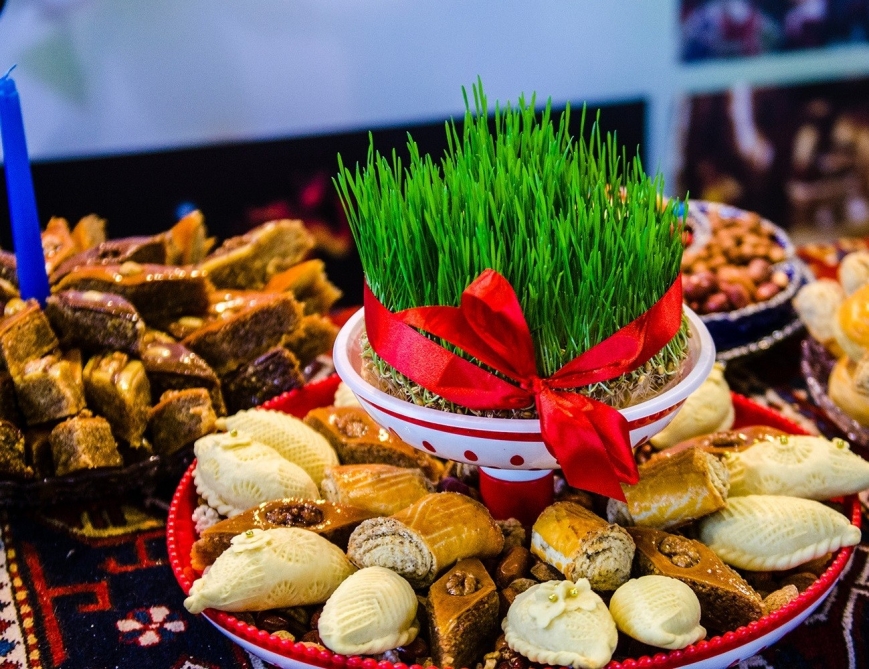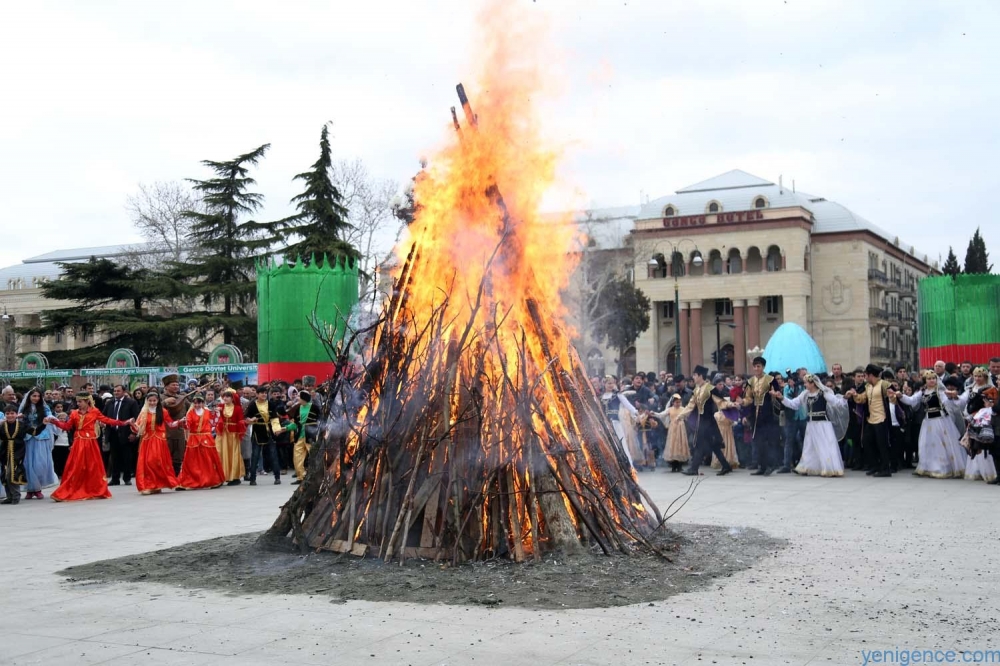Novruz Holiday
Novruz holiday is one of the oldest and most popular national holidays. Agriculture and animal husbandry, which laid the foundation of human evolution, played an important role in the economic life of the peoples of the Middle East, as well as the people of Azerbaijan.
Nowruz, the day of the spring equinox, is celebrated as the beginning of a new year by more than 300 million people around the world and has been celebrated for more than 3,000 years in the Balkans, the Middle East, the Caucasus, Central Asia, the Black Sea basin and some other regions.
The origin of Novruz holiday is very ancient. Novruz is considered the oldest natural holiday of the Turks. Chinese sources mention that the Huns held spring festivals on March 21. In the Turkic epic "Erganekon", the return to the old homeland is associated with the first day of spring.
Novruz holiday has been celebrated since 350 BC in the era of the Achaemenids, but its historical roots date back to the pre-Zoroastrian period. However, in Azerbaijan, samples of material culture with a spring motif were found on the rock paintings of Gobustan, Gamigaya, Apsheron (XII-VIII millennium BC), as well as in ancient settlements dating back to more ancient times.
Archaeological materials are considered important sources in determining the place of Nowruz holiday in the life and household of the Azerbaijani people. Significant materials about Novruz holiday, its essence, historical roots, connections with natural phenomena are also contained in written sources.
Thus, it becomes clear that in the minds of ancient people, was a ceremony of the spring awakening of nature after a long winter rest and a solemn meeting of the new year.
In the past, the arrival of Novruz, the first day when nature was resurrected - the new day was greeted with fireworks. Holiday preparations begin in the gray month of the winter season, and this period until Novruz is divided into 4 weeks from Wednesday to Wednesday.
The process of transition from winter to spring, getting rid of adversity, difficulties occurs during this period. They interpreted each of these Wednesdays with the four main forces of nature: water, fire, air and earth. The people celebrated the last Wednesdays of the year separately.
The beginning of four Tuesdays is the Tuesday of the elements of water (Su Charshanbyasi). According to ancient beliefs, water is a symbol of health and purity.
The first of four Wednesdays is called Water Wednesday. According to old beliefs, water symbolizes health and purity. Fire Wednesday, which came after Water Wednesday, was perceived as a source and protector of the good forces of the world. Based on ancient beliefs, arose based on the worship of the sun, fire.
Ancient Azerbaijanis considered the sun, fire, and hearth to be the life-giving divine power and worshiped them.
 The third of the four Wednesdays of the Gray Month is Wind Wednesday. It is also popularly called Windy Wednesday. According to ancient beliefs, on this Tuesday, the blowing wind sets in motion the water and fire awakened before it, warms the sleeping earth, awakens nature, takes away the pains and hardships of the earth. The fourth Wednesday of the gray month is called Earth Wednesday.
The third of the four Wednesdays of the Gray Month is Wind Wednesday. It is also popularly called Windy Wednesday. According to ancient beliefs, on this Tuesday, the blowing wind sets in motion the water and fire awakened before it, warms the sleeping earth, awakens nature, takes away the pains and hardships of the earth. The fourth Wednesday of the gray month is called Earth Wednesday.
Among the people, it is also known as Ilakhir Charshanba and Yer Charshanba. This Wednesday is a symbol of the awakening of the earth. According to ancient beliefs, with the awakening of the earth - the last of the four elements, which is considered the basis for all existing things in nature, water, wind, fire and earth gain greater power, nature changes its decoration, and people get rid of scarcity, hardship and distress.
People have always celebrated the last Wednesday of the year with great festivities, songs, games and ceremonies. Researchers connect the customs of making a bonfire, throwing flakes, and preparing a holiday table on Wednesdays with the old mythical world view. Having gained the power of light and the Sun, ancient people believed in the ability to exorcise alien spirits and evil forces with the help of fire. Mutual comparison of ethnographic information with literary sources shows that the custom of jumping over a bonfire is typical for Turkic peoples.
At the same time, among the ritual and celebratory signs of the interaction of man and nature on the Novruz holiday, we can note the customs of germinating wheat seeds, performances of traditional actors (Kechial and Kosa), calling the sun, building a bonfire, knocking on doors with a godu, putting an end to grief, commemorating those who have passed away, painting eggs, having egg fights, customs such as preparing Khoncha from seven types of blessings, cooking Shekerbura, Pakhlava, and Gogal, cleaning the house, yard and chimney, boiling a pot on the stove, throwing a hat, dangling khurj from the chimney, gathering at the stove, and going to ear fortune-telling.
Our nation has made an important contribution to the formation and development of Novruz holiday. Although there were strict bans on the celebration of Novruz during the Soviet era, our people have always been eager to celebrate it. Novruz holiday began to be held at the state level after the Republic of Azerbaijan gained independence.
The Novruz holiday, which is the embodiment of abundance, blessing and kindness, is already celebrated at the international level by UNESCO. As a result of the great efforts of the First Vice-President of the Republic of Azerbaijan, President of the Heydar Aliyev Foundation Mehriban Aliyeva, Novruz was inscribed on UNESCO’s Representative List of the Intangible Cultural Heritage of Humanity. On February 23, 2010, the UN The General Assembly recognized March 21 as the International Day of Novruz.
Novruz holiday is a holiday celebrated by our people for centuries. Novruz holiday is celebrated in Azerbaijan every year with great solemnity. This holiday is celebrated with great splendor in Baku-Seaside Park, Sumgait-Seaside Park and in the largest squares and stadiums in our regions. Novruz is our ancient holiday that expresses the common feelings and thoughts of the people and has an important place in the preservation and survival of Turkish culture. Our people have managed to preserve the traditions of this beautiful holiday for centuries, and the future generations will definitely preserve this valuable holiday which has a centuries-old history.
Recommended literature:
- Aslanov, Elçin Muxtar oğlu. Novruzun ulu sələfi / E. M. Aslanov. - Bakı : Səda, 2010. - 64 s.
- Azərbaycanda Novruz / tərt.-red. A. M. Nəbiyev, red. K. İslamzadə. - Bakı : Çıraq, 2012. - 272 s.
- Xəlil, Ağaverdi Sərxan oğlu. Türk xalqlarının yaz bayramları və Novruz / A. S. Xəlil ; elmi red. S. Xavəri ; AMEA Folklor İnstitutu. - Bakı : Elm və təhsil, 2012. - 144 s.